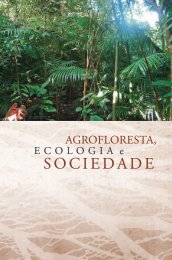Evolution of Oviductal Gestation in Amphibians
Evolution of Oviductal Gestation in Amphibians
Evolution of Oviductal Gestation in Amphibians
You also want an ePaper? Increase the reach of your titles
YUMPU automatically turns print PDFs into web optimized ePapers that Google loves.
406<br />
ln<br />
-<br />
ln<br />
3<br />
-<br />
12<br />
2 8<br />
0<br />
L<br />
m<br />
9<br />
5 4<br />
2<br />
. . . .<br />
. .<br />
.a.<br />
0<br />
. .... . .<br />
0<br />
0.. 0.<br />
0<br />
0<br />
.<br />
.<br />
0 . .<br />
.a .<br />
.<br />
320 340 360 380 400 420 440 460<br />
Maternal female total length (mm)<br />
Fig. 11. Female body size versus oviductal clutch size <strong>in</strong><br />
Dermophis mexicanus (after Wake, ’80b). Note that maternal<br />
body size is not correlated with clutch size <strong>in</strong> this viviparous<br />
species, <strong>in</strong> contrast to most amphibians.<br />
Fig. 12. Section through ovary, show<strong>in</strong>g vitellogenic ovum<br />
and corpus luteum <strong>in</strong> Scolecomorphus uittatus, a viviparous<br />
east African scolecomorphid caecilian (after Wake, ’68). Bar<br />
= 0.2 mm. c = capillary; cl corpus luteum; f = follicle; n =<br />
nucleus; y = yolk.<br />
M.H. WAKE<br />
placentae and that gaseous exchange and perhaps<br />
nutrient uptake occurs across the epithelial mem-<br />
brane <strong>in</strong>to the circulation. They describe the struc-<br />
ture <strong>of</strong> the gills as an ectotrophoblast. There have<br />
been no experimental tests <strong>of</strong> this hypothesis re-<br />
ported to date. Toews and Mac<strong>in</strong>tyre (’77) described<br />
the fetal-maternal 02-hemoglob<strong>in</strong> shiR <strong>in</strong> Typhlonec-<br />
tes. High O2 saturation <strong>of</strong> fetal blood can take place<br />
despite only “moderate” saturation <strong>of</strong> maternal blood.<br />
CONCLUSIONS<br />
Members <strong>of</strong> the three orders <strong>of</strong> the liv<strong>in</strong>g Amphia<br />
have converged on viviparity as a mode <strong>of</strong> repro-<br />
duction. There are some similarities <strong>in</strong> the ways<br />
they have achieved viviparity, but also many differ-<br />
ences. Only two species <strong>of</strong> frog and one <strong>of</strong> salamander<br />
are viviparous (a few others are ovoviviparous); but<br />
viviparity is a major mode <strong>of</strong> reproduction among<br />
caecilians, hav<strong>in</strong>g evolved at least twice and char-<br />
acteriz<strong>in</strong>g perhaps half or more <strong>of</strong> the 170 + species<br />
<strong>in</strong> the order, and there are no known ovoviviparous<br />
caecilians. Features <strong>of</strong> amphibian viviparity-<br />
ma<strong>in</strong>tenance <strong>of</strong> develop<strong>in</strong>g young <strong>in</strong> the oviducts<br />
<strong>of</strong> the female with maternal nutrition provided af-<br />
ter the yolk supply is exhausted-can be general-<br />
ized and summarized as follows:<br />
1. All viviparous amphibians have <strong>in</strong>ternal fer-<br />
tilization; this is a necessary but not sufficient com-<br />
ponent <strong>of</strong> viviparity. However, the means <strong>of</strong> <strong>in</strong>ternal<br />
fertilization differs among members <strong>of</strong> the three or-<br />
ders. Frogs use cloaca1 apposition; salamanders use<br />
spermatophore transfer via the substrate; caecilians<br />
<strong>in</strong>sert the male phallodeum <strong>in</strong>to the vent <strong>of</strong> the<br />
female.<br />
2. All viviparous amphibians have corpora lutea<br />
that appear to be <strong>in</strong>volved <strong>in</strong> ma<strong>in</strong>tenance <strong>of</strong> the<br />
pregnancy. The endocr<strong>in</strong>ology <strong>of</strong> the system is<br />
known only for the frog Nectophrynoides.<br />
3. All viviparous amphibians have relatively long<br />
gestation periods. Those <strong>of</strong> frogs apparently are rig-<br />
idly controlled by an <strong>in</strong>teraction <strong>of</strong> <strong>in</strong>ternal and<br />
environmental factors; the gestation period <strong>of</strong><br />
Salamandra atra is apparently very plastic (2-5<br />
years), but thought to be correlated with the rigor<br />
<strong>of</strong> the cold season; the gestation period <strong>of</strong> caecilians,<br />
based on only a few species, seems to be strongly<br />
tied to environmental factors, especially birth at<br />
the <strong>in</strong>ception <strong>of</strong> the ra<strong>in</strong>s, but is synchronous with<strong>in</strong><br />
a population.<br />
4. Viviparous amphibians characteristically have<br />
small ova and small clutches. The young are born<br />
fully metamorphosed. Ovoviviparous species, which






